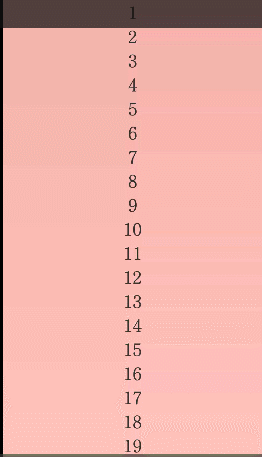其实早在去年七月,群里小伙伴就有让我共享这个。但我当时绝的技术不纯熟。代码有bug什么的。没有写出来。现在感觉整理的差不多了。就写出来让大家看看,有问题一起讨论解决。 说到刷新
其实早在去年七月,群里小伙伴就有让我共享这个。但我当时绝的技术不纯熟。代码有bug什么的。没有写出来。现在感觉整理的差不多了。就写出来让大家看看,有问题一起讨论解决。
说到刷新加载,我们第一个想到啥,对了就是swiperefreshlayout,还有什么SuperSwiperefreshlayout,XRecyclerView等等。反正老多了,我还是之前那句话,不管用什么,我们需要知道他的原理。
打造框架开始
对于刷新加载的实现,你们第一个想到的是什么?是用swiperefresh然后在recyclerview底部加一个不同type?还是用事件拦截呢?那必须是事件拦截啊,虽然现在swiperefreshlayout很火,基本很多app都能看到他。但是遇到那种坑比公司说刷新要用自己公司loGo你也没辙。对把。。好了,感觉得罪了好多公司,不管他,我们继续。
我们先看下我们的效果图:

老铁,没毛病。下面我介绍如何实现的。
下拉刷新
首先我们给出如下几个参数,后面要用:
private NestedScrollingParentHelper helper = null;
private boolean IsRefresh = true;
private boolean IsLoad = true;
//滑动的总距离
private int totalY = 0;
private LinearLayout headerLayout = null;
private MyRecyclerView myRecyclerView = null;
private LinearLayout footerLayout = null;既然是刷新,我们的滚动肯定是在父view之前的。所以我们需要在onNestedPreScroll这个方法里面写上我们所需要改动的x,y值。
我们需要用父view去拦截它。
我们需要判断dy的值是否大于0,因为大于0是刷新操作,小于0是加载操作。然后我们需要判断recyclerview是否是纵向的而不是横向的。
public void onNestedPreScroll(View target, int dx, int dy, int[] consumed) {
if (IsRefresh) {
if (dy > 0) {
if (myRecyclerView.isOrientation(0)) {
totalY += dy;
if ((totalY / 2) <= 0) {
scrollTo(0, totalY / 2);
consumed[1] = dy;
} else {
scrollTo(0, 0);
consumed[1] = 0;
}
}
return;
}
}
上拉加载
上面我也说了onNestedPreScroll这个方法中判断dy<0才是加载操作。所以综上所述,代码变成了这样:
public void onNestedPreScroll(View target, int dx, int dy, int[] consumed) {
if (totalY < 0 && myRecyclerView.isOrientation(0) || totalY > 0 && myRecyclerView.isOrientation(1)) {
isfling = true;
}
if (IsRefresh) {
if (dy > 0) {
if (myRecyclerView.isOrientation(0)) {
totalY += dy;
if ((totalY / 2) <= 0) {
scrollTo(0, totalY / 2);
consumed[1] = dy;
} else {
scrollTo(0, 0);
consumed[1] = 0;
}
}
return;
}
}
if (IsLoad) {
if (dy < 0) {
if (myRecyclerView.isOrientation(1)) {
totalY += dy;
if ((totalY / 2) >= 0) {
scrollTo(0, totalY / 2);
consumed[1] = dy;
} else {
scrollTo(0, 0);
consumed[1] = 0;
}
}
return;
}
}
}
最后我们需要在子view滑动结束后,实行如下操作:
//子view滑动结束调用
//dyUnconsumed < 0 向下滚
//dyUnconsumed > 0 向上滚
public void onNestedScroll(View target, int dxConsumed, int dyConsumed, int dxUnconsumed, int dyUnconsumed) {
if (dyUnconsumed != 0) {
totalY += dyUnconsumed;
scrollTo(0, totalY / 2);
}
}
其实最主要的两个方法已经解决了,其他到没什么了,这边,我把nestedscrolling的8个接口的功能和自定义recyclerview放出来。已变大家参考。希望大家都能实现自己的刷新加载。告别swiperefreshlayout。
添加header和footer
这里我们参考listview自带的addheaderview和addfooterview。代码如下:
public void addHeaderView(View headerView, int headerHeight) {
this.headerLayout.removeAllViews();
this.headerLayout.addView(headerView);
LayoutParams layoutParams = new LayoutParams(LayoutParams.MATCH_PARENT, headerHeight);
layoutParams.topMargin = -headerHeight;
this.headerLayout.setLayoutParams(layoutParams);
}
public void addFooterView(View footerView, int footerHeight) {
this.footerLayout.removeAllViews();
this.footerLayout.addView(footerView);
this.footerLayout.setLayoutParams(new LayoutParams(LayoutParams.MATCH_PARENT, footerHeight));
}
几个接口的实现
public boolean onStartNestedScroll(View child, View target, int nestedScrollAxes) {
return true;
}
public void onNestedScrollAccepted(View child, View target, int axes) {
helper.onNestedScrollAccepted(child, target, axes);
}
//父view拦截子view的滚动
public void onNestedPreScroll(View target, int dx, int dy, int[] consumed) {
if (totalY < 0 && myRecyclerView.isOrientation(0) || totalY > 0 && myRecyclerView.isOrientation(1)) {
isfling = true;
}
if (IsRefresh) {
if (dy > 0) {
if (myRecyclerView.isOrientation(0)) {
totalY += dy;
if ((totalY / 2) <= 0) {
scrollTo(0, totalY / 2);
consumed[1] = dy;
} else {
scrollTo(0, 0);
consumed[1] = 0;
}
}
return;
}
}
if (IsLoad) {
if (dy < 0) {
if (myRecyclerView.isOrientation(1)) {
totalY += dy;
if ((totalY / 2) >= 0) {
scrollTo(0, totalY / 2);
consumed[1] = dy;
} else {
scrollTo(0, 0);
consumed[1] = 0;
}
}
return;
}
}
}
//子view滑动结束调用
//dyUnconsumed < 0 向下滚
//dyUnconsumed > 0 向上滚
public void onNestedScroll(View target, int dxConsumed, int dyConsumed, int dxUnconsumed, int dyUnconsumed) {
if (dyUnconsumed != 0) {
totalY += dyUnconsumed;
scrollTo(0, totalY / 2);
}
}
public void onStopNestedScroll(View child) {
helper.onStopNestedScroll(child);
if (onTouchUpListener != null) {
isfling = false;
onTouchUpListener.touchUp();
}
}
public boolean onNestedFling(View target, float velocityX, float velocityY, boolean consumed) {
return isfling;
}
public boolean onNestedPreFling(View target, float velocityX, float velocityY) {
return isfling;
}
public int getNestedScrollAxes() {
return helper.getNestedScrollAxes();
}
自定义recyclerview
既然是自己写的刷新加载框架,总不能还有自定义layout中在放个recyclerview。多麻烦,自定义一个,直接放在里面,然后分别放个header和footer 就没必要每次有页面用到刷新都要写一个布局。3个布局解决整个项目的刷新和加载。话不多说,代码如下:
private class MyRecyclerView extends RecyclerView {
private StaggeredGridLayoutManager staggeredGridLayoutManager = null;
private LinearLayoutManager linearLayoutManager = null;
private GridLayoutManager gridLayoutManager = null;
private boolean isScrollLoad = false;
private boolean isScrollRefresh = false;
public MyRecyclerView(Context context) {
super(context);
setVerticalFadingEdgeEnabled(false);
setHorizontalFadingEdgeEnabled(false);
setVerticalScrollBarEnabled(false);
setHorizontalScrollBarEnabled(false);
setOverScrollMode(OVER_SCROLL_NEVER);
setItemAnimator(new DefaultItemAnimator());
}
private void setMyLayoutManager(LayoutManager layoutManager) {
if (layoutManager instanceof StaggeredGridLayoutManager) {
staggeredGridLayoutManager = (StaggeredGridLayoutManager) layoutManager;
} else if (layoutManager instanceof GridLayoutManager) {
gridLayoutManager = (GridLayoutManager) layoutManager;
} else if (layoutManager instanceof LinearLayoutManager) {
linearLayoutManager = (LinearLayoutManager) layoutManager;
}
setLayoutManager(layoutManager);
if (!isVertical()) {
throw new NullPointerException("vertical!");
}
}
private boolean isOrientation(int orientation) {//orientation,0代表向下,1代表向上
if (orientation == 0)
return isCanPullDown();
else if (orientation == 1)
return isCanPullUp();
return false;
}
private boolean isCanPullDown() {
return !canScrollVertically(-1);
}
private boolean isCanPullUp() {
return !canScrollVertically(1);
}
// private int scrollLoad() {
// int lastItem = 0;
// int itemCount = 0;
// int spanCount = 1;
// if (staggeredGridLayoutManager != null) {
// lastItem = staggeredGridLayoutManager.findLastVisibleItemPositions(null)[0];
// itemCount = staggeredGridLayoutManager.getItemCount();
// spanCount = staggeredGridLayoutManager.getSpanCount();
// } else if (linearLayoutManager != null) {
// lastItem = linearLayoutManager.findLastVisibleItemPosition();
// itemCount = linearLayoutManager.getItemCount();
// spanCount = 1;
// } else if (gridLayoutManager != null) {
// lastItem = gridLayoutManager.findLastVisibleItemPosition();
// itemCount = gridLayoutManager.getItemCount();
// spanCount = gridLayoutManager.getSpanCount();
// }
// return ((itemCount - 1) / spanCount + 1) - (lastItem / spanCount + 1);
// }
private boolean isVertical() {
if (staggeredGridLayoutManager != null)
return staggeredGridLayoutManager.getOrientation() == StaggeredGridLayoutManager.VERTICAL;
else if (linearLayoutManager != null)
return linearLayoutManager.getOrientation() == LinearLayoutManager.VERTICAL;
else if (gridLayoutManager != null)
return gridLayoutManager.getOrientation() == GridLayoutManager.VERTICAL;
return false;
}
// public void onScrolled(int dx, int dy) {
// if (dy > 0 && !isScrollLoad) {
// if (oLior != null) {
// onScrollListener.scrollLoad(sc````````
`
``
llLoad());//传递滚动到倒数第几行
// }
// }
// }
}
这样我们变实现了自己的刷新加载框架,代码我已上传:SWPullRecyclerLayout_jb51.rar
--结束END--
本文标题: android教你打造独一无二的上拉下拉刷新加载框架
本文链接: https://lsjlt.com/news/22003.html(转载时请注明来源链接)
有问题或投稿请发送至: 邮箱/279061341@qq.com QQ/279061341
2024-01-21
2023-10-28
2023-10-28
2023-10-27
2023-10-27
2023-10-27
2023-10-27
回答
回答
回答
回答
回答
回答
回答
回答
回答
回答
0